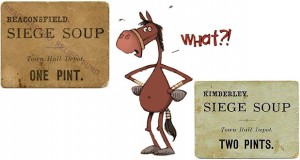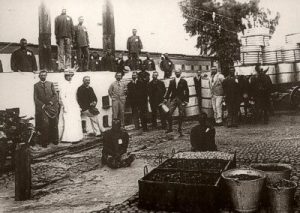UPDATED: 08/01/2024
8 January 1887, William Smith shoots his wife Sarah dead in Sidney Street.
8 January 1900, Horseflesh being given out as food during the siege for first time.
Siege rationing gets serious
J.W. McBeath, a chemist on Stockdale Street, had the idea of a soup kitchen in order to assist those suffering from lack of sustenance during the siege, although it was Rhodes who implemented the idea, with Tim Tyson doing the actual planning and work involved. Assisting Tyson were Dr Thomas Smartt and Julia Rochefort Maguire, The Times of London correspondent during the siege, and it was she who had the dubious honour of sampling the first pint issued.
On the first day, 8 January, over 3000 pints were issued, with an average of 2500 pints a day from then onwards, the cost being 3d a pint. Vegetables from Kenilworth went into the mix, as did at least 600 horses notwithstanding official denial.

Dr Smartt believed that Cecil Rhodes should also have some of the horse soup in full view of the public to prove to them that it was tasty and nutritious. Rhodes was, however, not enamoured of the horse soup despite being assured that it was just as good as the beef soup also available. Rhodes bargained with Smartt that he should have the beef soup first, which he consumed, and then tried to persuade Smartt that he would have the horse soup the next day. But Smartt had already given Rhodes the horse soup instead of the beef soup and Rhodes never knew the difference.
(The photograph is taken on 8 January 1900 in the De Beers Convict Station off what is now Hull Street. The first batch of soup, as in the story, has just been made. The majority of the men pictured are convicts – the men with what appears to be badges on their shirts. The convicts were working for De Beers.)
UPDATED: 08/01/2021
8 January 1887, William Smith shoots his wife Sarah dead in Sidney Street.
8 January 1900, Horseflesh being given out as food during the siege for first time.
It was on Sidney Street that the crime writer Benjamin Bennett was raised as a child and it is where his mother died through a doctor’s criminal neglect. It was also the scene of a violent crime where William Henry Smith killed his wife, Sarah (Annie) Burnside Smith, by shooting her with a revolver.
On 8 January 1887, a resident of Sidney Street, William Smith, a carpenter by trade and a person subject to alternating between alcoholic binges and fits of religious fervour, was having one of his drinking bouts. He had been drinking heavily all week, and his wife Sarah had been having arguments with him about his behaviour, and about his forthcoming trip to the gold fields.
Tired of his drinking habits, Sarah had convinced Smith to seek his fortune anew at the gold fields, and Smith had literally jumped at the chance of temporarily escaping from his life in Kimberley and tasting once more some freedom away his wife. He had bought many necessities, among which was a pin-firing revolver.
Living in a small house on the Smiths’ premises in front of the kitchen was Stephen Belmore, next-door was the residence and practice of Dr Otto, and opposite lived the Gosvowler family. Shortly before 1pm Belmore heard a single shot.
Belmore – a tent maker by profession – came out of his house just in time to see Sarah come running around the corner holding the small of her back with one hand and her groin with the other. She was screaming and ran over the road to the Gosvowler residence. Meanwhile Belmore ran towards Smith’s residence and heard another two shots –
Smith was on the verandah behind some creepers and Belmore saw him place the revolver in his pocket and walk away. Belmore, who had been joined by passerby John Swaebe, asked him what he was doing, and Smith replied that he was just firing off some crackers like little boys did. Swaebe thought that Smith did not know that he had shot anyone, and when arrested, seemed surprised.
Detectives Smith and MacPherson arrived on the scene, as did a sizeable crowd, and while Smith, the policeman, climbed through the window and pushed the murderer Smith onto the bed, the incensed crowd broke down the door. The capture of the drunken Smith calmed the crowd down and the police took him away. The revolver was found hidden in the bedroom, while the four spent cartridge cases were discovered concealed on a shelf in the kitchen.
Sarah, in the meantime, had met up with Mrs Gosvowler at the gate to her house as the latter had heard the shooting and screaming and come to see what the commotion was about. “Mrs Gosvowler, I’m shot”, was all she said and collapsed in her arms. When another shot was heard, Sarah jumped up and ran screaming to Dr Otto’s house and went inside. Dr Otto examined Sarah, and found that she had been shot in the back and the bullet had lodged in her left groin.
Blood was oozing from the wound and she was in terrible pain. He sent her immediately to the hospital where she was treated but never recovered, dying on 15 January from “absorption of purulent matter from the pelvis, occasioned by the gunshot wound”.
William Henry Smith went on trial for his life before Mr Justice Laurence on 19 April 1887. Advocate Feltham appeared for the defence.
The Crown Prosecutor, in his final address to the jury, told them that there were only three courses open to them – guilty of wilful murder, guilty of culpable homicide, or, not guilty. The latter verdict would be absolutely impossible, he argued, while the culpable homicide was not an issue as Smith had hidden the revolver and the cartridge cases. He must have known exactly what he had done, and what was happening around him. Therefore, he must surely be guilty of murder. Advocate Feltham, for the defence, told the jury that there was no “malice aforethought” before the shooting of Sarah Smith that distinguishes murder from manslaughter. Looking through all the evidence, Feltham contended, Smith should be guilty of culpable homicide rather than of murder.
He was irresponsible for the deed, and ignorant of the consequences, Feltham continued.
Summing up the evidence, Judge Laurence advised the jury that if they considered “that there had in the mind of the prisoner previously existed a wicked intention to commit the deed” they should then bring in a verdict of murder. There was no proof of insanity, the Judge continued, and the law held that the immorality of drunkenness was no excuse for any criminal act that might follow.
The jury retired for twenty minutes, returning to advise that they could not agree on a decision and could not fully understand the fine line that separates murder from culpable homicide. Mr Justice Laurence explained further the differences between the two, especially on culpable homicide, and the jury again retired. After about an hour deliberation, they returned and delivered a verdict of guilty of willful murder, but recommended mercy on the grounds of his excited state at the time brought on by excessive drink.
When asked if he had anything to say before the Judge donned his black cap, William Smith rose and addressed the court: “As far as my intellect is concerned, I am innocent of the charge, I never bore any malice against my wife; I have lost my all, and it matters little what the end be.”
Mr Justice Laurence said that the recommendation for mercy would be forwarded to the proper authorities, but “he would urge on him, the prisoner, not to place any trust or hope in the recommendation”. With that, he placed the black cap upon his head, and the sentence of death was passed in the usual form.
From Kimberley Calls and Recalls on Facebook By Steve Lunderstedt
Shortlink for this post: https://www.kimberley.org.za/?p=7248








